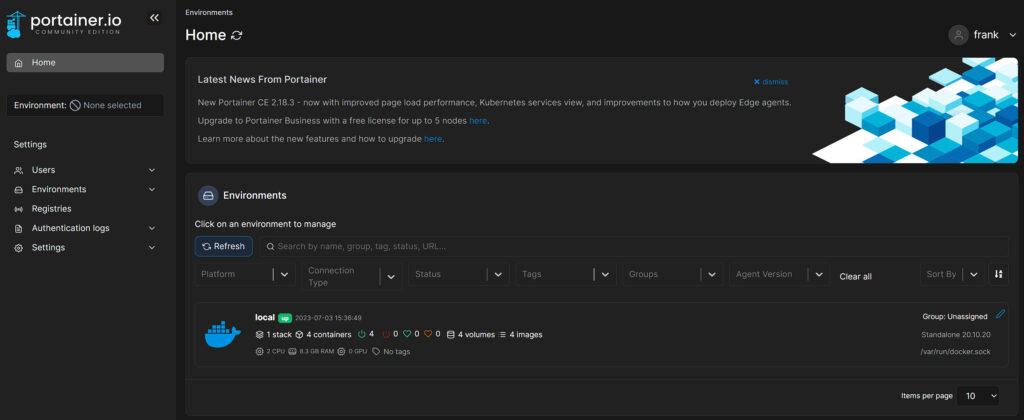In this article, we’re going to look at Yacht vs. Portainer to determine which Docker management interface is best.
If you’re using Docker in any capacity, you know that interacting with it through the command-line interface (CLI) can be frustrating. Yacht and Portainer offer a full GUI for Docker, which allows you to manage all of your Docker containers in an easy-to-use management user interface.
Yacht and Portainer are similar, but have key differences from an everyday usage perspective, so we’ll compare some of their features and capabilities below to help you determine which option is best. These are great options but keep in mind that you can go with totally different options as well like Rancher.
Do You Need a Management Interface for Docker?
Technically, you can use Docker through the command-line interface only, and using a management interface like Yacht or Portainer isn’t necessary. However, they simplify the overall operation of both and allow you to easily manage your Docker containers with a great GUI.
This allows you to manage existing containers, or simply create new ones in an easier way and beginners may find the user interface necessary for everyday usage. It also helps to visualize how containers function which can give you a better overall understanding of how Docker works.
Yacht vs. Portainer: Side-by-Side Comparison
We’ll take a look at the major differences between Yacht and Portainer below, but before we do, let’s look at what Yacht and Portainer are.
What is Yacht?
Yacht is an application that provides a web interface for managing Docker containers with an emphasis on simplicity and ease of use. It is an open-source project that can help users, especially those new to Docker, manage their containerized applications more easily.
Yacht allows users to create, start, stop, and monitor Docker containers from a web-based user interface. You can manage multiple containers simultaneously, view real-time logs, inspect container details, and access other Docker features without having to write a single line of code or command-line instructions.

Features of Yacht
Yacht has many features that are similar to Portainer, but the key difference is that the entire user interface is designed with simplicity in mind. Here are some key features of Yacht:
- Application Deployment: You can deploy applications using Docker Compose or pre-made templates.
- Container Management: Start, stop, and monitor Docker containers directly from the web interface.
- Logs and Statistics: Real-time access to logs and stats of your containers.
- Easy Yacht Update: Yacht has one of the easiest ways that I’ve seen for updating a Docker management user interface (and is much easier than Portainer). All you have to do is access the settings and the update tab, and you can update Yacht to the latest version by using a run-once Watchtower instance.

What is Portainer?
Portainer is an open-source platform that provides a user-friendly interface for managing Docker, Docker Swarm, Kubernetes, and Azure ACI environments. It allows users to manage their containerized applications, images, networks, and volumes from a single, unified dashboard.
With Portainer, you can deploy applications, monitor the status of running containers, and troubleshoot application issues without using the command-line interface. This is particularly useful for teams that are new to Docker or Kubernetes, as well as for experienced developers looking for a more efficient way to manage their applications.

There are various devices that users like to install Portainer on, as it’s one of, if not the most commonly used Docker management interface.
Features of Portainer
Portainer has all of the functionality that Yacht has, plus many additional items:
- Container Management: Create, start, stop, and monitor Docker containers directly from the web interface. You can also access logs, stats, and console details of each container.
- App Templates: Deploy pre-built templates for common applications with just a few clicks, saving time in setting up and deploying new containers.
- Role-Based Access Control (RBAC): Assign roles to users and manage their access to resources.
- Multi-Environment Management: You can manage multiple Docker environments (Docker standalone, Docker Swarm, or Kubernetes) from a single Portainer instance.
- Registry Management: Connect to and manage Docker registries, making it easier to store and distribute your Docker images.

Yacht & Portainer Install Instructions
Yacht and Portainer are installed as containers, so their individual setup process is similar to any other Docker container. However, since they’re a GUI, you generally must install them both from the command-line interface.
Fortunately, the install process is an individual command and you don’t have to worry about modifying many (if any) parameters. The volume for each will allow you to maintain persistent data (in case you ever want to move them).
Yacht Install Command:
docker volume create yacht
docker run -d -p 8000:8000 -v /var/run/docker.sock:/var/run/docker.sock -v yacht:/config --name yacht selfhostedpro/yachtPortainer Install Command:
docker volume create portainer_data
docker run -d -p 8000:8000 -p 9443:9443 --name portainer --restart=always -v /var/run/docker.sock:/var/run/docker.sock -v portainer_data:/data portainer/portainer-ce:latestThere are also scenarios where you can install Yacht and Portainer automatically, like if you’re using OMV-extras and OpenMediaVault.
Main Difference Between Yacht and Portainer
The main difference between Yacht and Portainer is that Yacht is significantly more user-friendly, while Portainer is more feature-filled.
Overall, Portainer and Yacht are designed to simplify Docker management through their user-friendly web-based interfaces and Yacht generally excels from a simplicity perspective. Portainer, on the other hand, is significantly more feature-filled and provides users with the ability to manage other environments like Docker Swarm and Kubernetes.
Here are a few other key differences between Yacht and Portainer:
- Project Maturity: Portainer is a more mature project, having been around since 2015. It has seen widespread adoption and developed a sizable user community. On the other hand, Yacht is a newer project and has a smaller user base.
- Supported Environments: Portainer has wider environment support, extending its functionality beyond Docker and Docker Swarm to include Kubernetes and Azure ACI. Yacht primarily focuses on Docker environments.
- User Interface: The user interfaces of Portainer and Yacht differ significantly. Yacht maintains a minimalistic and straightforward interface, focusing on simplicity and ease of use. Alternatively, Portainer has a more comprehensive interface, providing a greater array of options and functionalities for those requiring more control and customization.
- Role-Based Access Control (RBAC): Portainer supports RBAC, which is an important feature for teams as it allows administrators to define access levels and permissions for different users.
- Application Templates: Both platforms support application deployment using templates, but they handle it differently.
Conclusion & Final Thoughts on Yacht and Portainer
This tutorial looked at the differences between Yacht vs. Portainer. If you’re someone who prefers simplicity, you can’t go wrong with Yacht as it will allow you to manage your Docker containers and doesn’t provide any of the advanced features (which some will classify as bloat) that Portainer does.
However, from a pure functionality perspective, Portainer is significantly more feature-filled and will provide users and teams to manage significantly more when it comes to their containers.
To highlight that, Portainer has a free (Community Edition) and business tier (Business Edition), which offers a different set of features depending on the requirements. Individuals and home lab enthusiasts will be fine with the Community Edition, though the Business Edition exists for enterprise use.
Either way, you can’t go wrong, and in many cases, should try both (they’re both free) to determine which you like best. Thanks for checking out the article on Yacht vs. Portainer. If you have any questions, please leave them in the comments!




